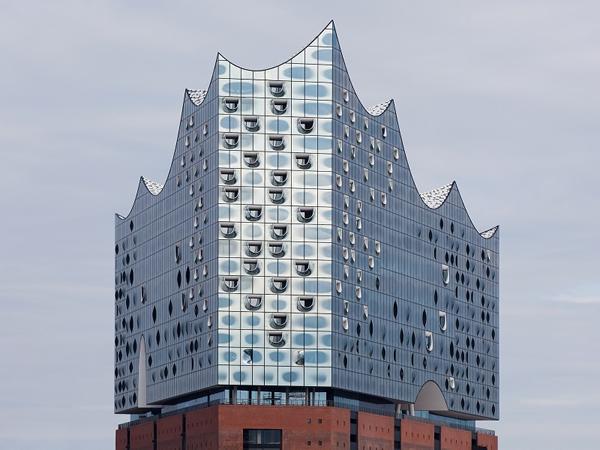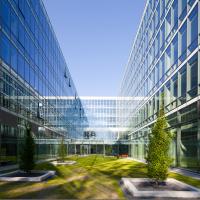
Date: 31 August 2017
Located on the Elbe River, on the western tip of the HafenCity in Hamburg, Germany, the Elbphilharmonie is one of the largest and most acoustically advanced concert halls in the world and an outstanding example of modern architecture.
The Elbphilharmonie boasts stunning architecture in the mixed-used facility. Designed by Herzog & de Meuron, the building is not just a site for music; it is a fully-fledged residential and cultural complex.
The 108-metre-high building, which officially opened in January 2017, accommodates a philharmonic hall, a chamber music hall, restaurants, bars, a terrace with panoramic views of Hamburg and the harbour, luxury apartments, a hotel, fitness centre, conference rooms and parking facilities.
The design of the new glass building resembles a hoisted sail or water wave. Extruded from the shape of the original Kaispeicher warehouse that supports it, the new glass building is identical in ground plan with the brick block of the older building, above which it rises. However, at the top and bottom, the new structure takes a very different design from the quiet, plain shape of the warehouse below.

Complex curved glass façade
The new building’s stunning 21,800m2 glass façade consists in part (approx. 5,000m2) of curved glass that transforms the structure into an enormous quartz crystal, whose appearance continually changes as it catches the reflections of the sky, the water and the city lights.
Josef Gartner GmbH was responsible for developing the glass façade. It is comprised of both flat and curved insulating glass units (IGUs) for the windows, as well as triple laminated curved single glazing for the loggias (covered exterior galleries).

One of the challenges was developing the curved glass elements of the façade. Up to that time, nobody has ever bent glass panes of that complex 3-D-geometry.
The next challenge was to maintain the functions of the different coatings of the glass during the manufacturing process. The glazing of the façade consists of a low-E coating, a solar control coating, chrome mirror dots and a ceramic silk-screen pattern.
The solar control coating and the chrome dots were vital in achieving the customers’ performance requirements. Gartner was concerned that the high temperatures in the bending oven would destroy these layers or adversely affect their performance.

“We talked with many companies, but Guardian was the only one that could offer a base layer that would guarantee that the sun protection layer maintains its functions during the manufacturing process”, says Karl Lindenmaier, Senior Project Manager Elbphilharmonie at Josef Gartner. “In close collaboration with Guardian, we were able to achieve and maintain the customers’ requirements.”
As well as working with Gartner during the façade design phase, the Guardian Glass team also worked closely with the curved glass processor, SunGlass Srl. This ensured that the curved glass met the architect’s requirements in terms of performance and aesthetics (i.e. shapes of the curved glass, appearance and colour reflections).

Products supplied by Guardian Glass
The architects, Herzog & de Meuron, selected as a base glass for the whole façade Guardian ExtraClear® float glass for its combination of transparency, aesthetics and performance.
Guardian also supplied its coated solar control glass, SunGuard® Solar Light Blue 52. This product provided sufficient stability during the glass bending process, while also meeting the architect’s requirements. In a standard insulating glass unit*, SunGuard Solar Light Blue 52 provides a visible light transmission of 47%.

It also has a low solar factor of 36% to help reducing demands on the building’s air conditioning and controlling the temperature inside the building. Furthermore, the SunGuard Solar Light Blue 52 coating provided the possibility of applying the ceramic silk-screen pattern directly on the coating.
To provide complete performance for the curved IGU windows, Guardian supplied its ClimaGuard® DT thermally insulating coated glass. This product combines neutrality, thermal insulation, durability and easy processing. It offered a remarkably high stability during the glass bending process, while also meeting the architect’s requirements.

Technical support services
In addition to supplying the high performance coated glass products, Guardian also provided technical support including thermal and spectrophotometric glazing calculation data, and thermal stress analyses.
Using its vast experience and knowledge base, Guardian was also able to provide invaluable suggestions and guidance on glass bending and ceramic printing of coated glass.

*6 mm SunGuard Solar Light Blue 52, coating on #2 – 16 mm Argon – 4 mm Guardian ClimaGuard Premium2, coating on surface #3
Guardian Glass is a major business unit of Guardian Industries Corp. For more information on the products used in the Elbphilharmonie, please visit www.guardianglass.com or www.sunguardglass.com.




 600450
600450




























Add new comment